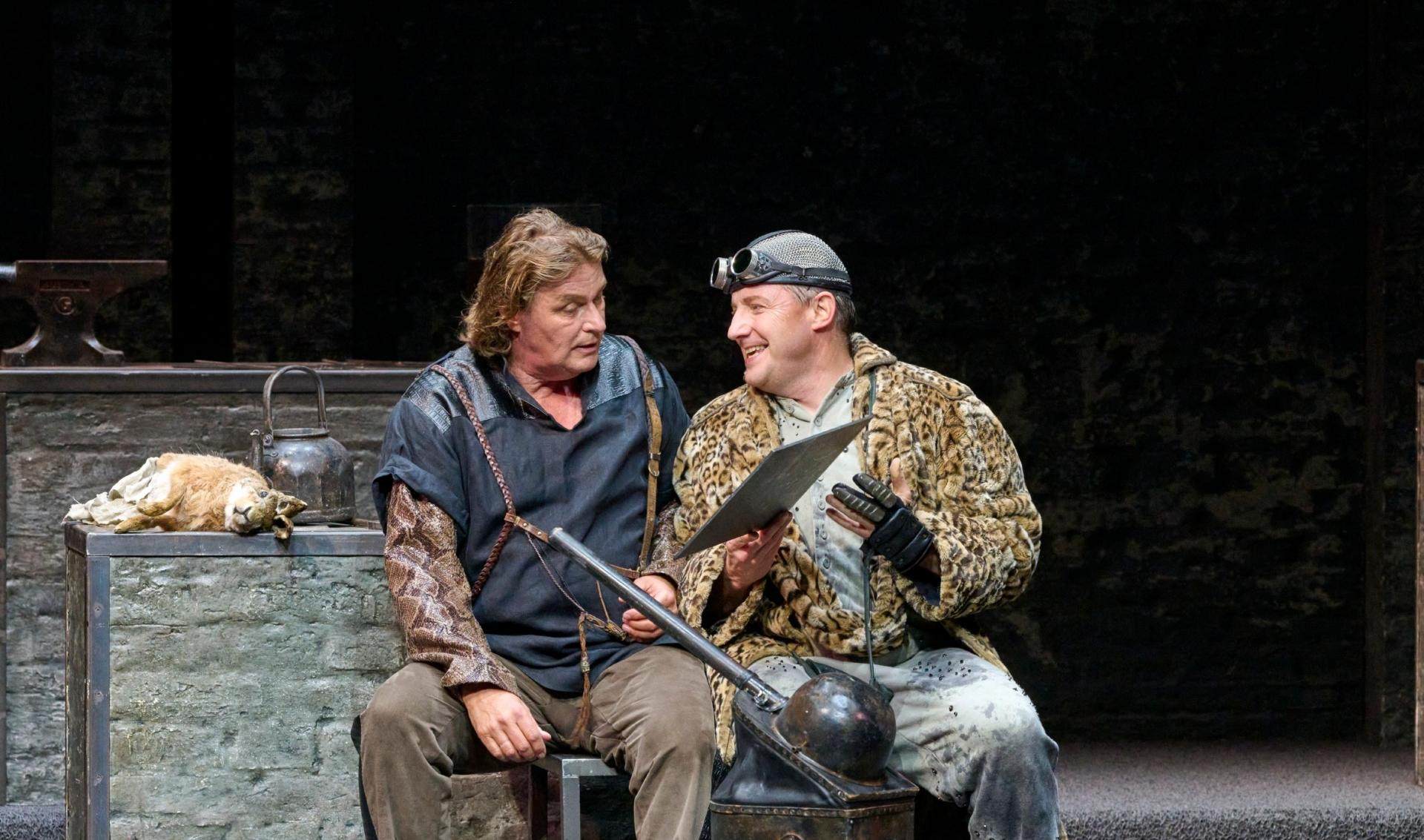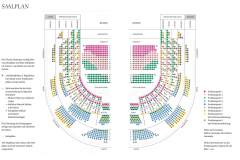Siegfried
Mo | Tu | We | Th | Fr | Sa | Su |
Siegfried - Richard Wagner | Opera
Act 1: 90 minutes
Intermission: 25 minutes
Act 2: 90 minutes
Intermission: 25 minutes
Act 3: 95 minutes
Synopsis
ACT 1
Siegfried grew up with Mime, the blacksmith, in the forest. When he searches for his parents, Mime tells him about Siegfried's mother, who died giving birth to him, leaving behind only the broken sword Nothung, which his father carried in his last battle.
When Siegfried is once again out and about in the forest, a Wanderer appears, who is recognized as Wotan, and challenges Mime to a wager of knowledge, which he loses. Mime learns from the Wanderer that only someone who does not know fear can reforge the sword Nothung. Mime knows that this person is Siegfried and promises him that he will learn to fear by fighting the dragon Fafner. He secretly hopes that Siegfried will help him obtain the Nibelung ring and the Nibelung hoard guarded by Fafner. Siegfried succeeds in forging the sword Nothung at the first attempt.
ACT 2
Mime's brother Alberich keeps watch outside the dragon's lair.
The Wanderer, who visits him, announces the arrival of Mime and Siegfried. Alberich's attempt to persuade Fafner to hand over the ring fails. Siegfried kills Fafner after a brief battle. After the dragon's blood has wetted Siegfried's mouth, he understands the language of the birds. A forest bird draws Siegfried's attention to the Ring, the Tarnhelm and the hoard. He kills Mime, who has rushed back to Siegfried's side and is seeking his life, with the sword Nothung and follows the forest bird, who tells him about the sleeping Brünnhilde.
ACT 3
The Wanderer wakes Erda and tells her that he wishes to abdicate in favor of the young Siegfried.
Siegfried rushes over and treats the Wanderer no differently than he did Mime. He smashes the Wanderer's spear, which once broke Siegfried's father Siegmund's sword, and makes his way to the rock. There he finds the sleeping Brünnhilde, whom he awakens.
Both awaken in love for each other.
Program and cast
Siegfried: Andreas Schager
Brünnhilde: Anja Kampe
The Wanderer: Iain Paterson
Alberich: Jochen Schmeckenbecher
Erda: Noa Beinart
Mime: Michael Laurenz
Fafner: Kwangchul Youn
Voice of the forest bird: Ileana Tonca
Conductor: Philippe Jordan
Director: Sven-Eric Bechtolf
Stage: Rolf Glittenberg
Costumes: Marianne Glittenberg
Video: fettFilm (Momme Hinrichs and Torge Möller)
May and June 2026
Siegfried: Andreas Schager
Brünnhilde: Camilla Nylund
The Wanderer: Michael Volle
Alberich: Georg Nigl
On the ground: Wiebke Lehmkuhl
Mime: Gerhard Siegel
Fafner: Matheus France
Voice of the forest bird: Florina Ilie
Conductor: Pablo Heras-Casado
Director: Sven-Eric Bechtolf
stage: Rolf Glittenberg
Costumes: Marianne Glittenberg
Video: fettFilm (Momme Hinrichs and Torge Möller)
Vienna State Opera
Public Transport
Subway lines: U1, U2, U4
Trams: 1, 2, D, J, 62, 65
Buses: 59A
Local Railway: Badner Bahn
Stops: Karlsplatz / Opera
Taxi stands are available nearby.
Parking
Parking is only € 6, - for eight hours!
The Wiener Staatsoper and the ÖPARK Kärntner Ring Garage on Mahlerstraße 8, under the “Ringstraßengalerien”, offer the patrons of the Vienna State Opera a new, reduced parking fee. You can park in the Kärntner Ring Garage for up to 8 hours and pay only a flat fee of € 6, -. Just validate your ticket at one of the discount machines inside the Wiener Staatsoper. The normal rate will be charged for parking time greater than 8 hours. The validation machines can be found at the following coat checks: Operngasse, Herbert von Karajan-Platz, and the right and left and balcony galleries.
Important: In order to get the discount, please draw a ticket and do not use your credit card when entering the garage!
After devaluing your ticket in the Wiener Staatsoper you can pay comfortably by credit card or cash at the vending machines.
The machines accept coins and bills up to 50.- Euro. Parking time longer than 8 hours will be charged at the normal rate.
History
The structure of the opera house was planned by the Viennese architect August Sicard von Sicardsburg, while the inside was designed by interior decorator Eduard van der Nüll. It was also impacted by other major artists such as Moritz von Schwind, who painted the frescoes in the foyer, and the famous "Zauberflöten" (“Magic Flute”) series of frescoes on the veranda. Neither of the architects survived to see the opening of ‘their’ opera house: the sensitive van der Nüll committed suicide, and his friend Sicardsburg died of a stroke soon afterwards.
On May 25, 1869, the opera house solemnly opened with Mozart's Don Giovanni in the presence of Emperor Franz Joseph and Empress Elisabeth.
The popularity of the building grew under the artistic influence of the first directors: Franz von Dingelstedt, Johann Herbeck, Franz Jauner, and Wilhelm Jahn. The Vienna opera experienced its first high point under the direction of Gustav Mahler. He completely transformed the outdated performance system, increased the precision and timing of the performances, and also utilized the experience of other noteworthy artists, such as Alfred Roller, for the formation of new stage aesthetics.
The years 1938 to 1945 were a dark chapter in the history of the opera house. Under the Nazis, many members of the house were driven out, pursued, and killed, and many works were not allowed to be played.
On March 12, 1945, the opera house was devastated during a bombing, but on May 1, 1945, the “State Opera in the Volksoper” opened with a performance of Mozart's THE MARRIAGE OF FIGARO. On October 6, 1945, the hastily restored “Theaters an der Wien” reopened with Beethoven's FIDELIO. For the next ten years the Vienna State Opera operated in two venues while the true headquarters was being rebuilt at a great expense.
The Secretary of State for Public Works, Julius Raab, announced on May 24, 1945, that reconstruction of the Vienna State Opera would begin immediately. Only the main facade, the grand staircase, and the Schwind Foyer had been spared from the bombs. On November 5, 1955, the Vienna State Opera reopened with a new auditorium and modernized technology. Under the direction of Karl Böhm, Beethoven’s FIDELIO was brilliantly performed, and the opening ceremonies were broadcast by Austrian television. The whole world understood that life was beginning again for this country that had just regained its independence.
Today, the Vienna State Opera is considered one of the most important opera houses in the world; in particular, it is the house with the largest repertoire. It has been under the direction of Dominique Meyer since September 1, 2010.

 EN
EN DE
DE IT
IT FR
FR ES
ES RU
RU JP
JP RO
RO
 Seating plan
Seating plan